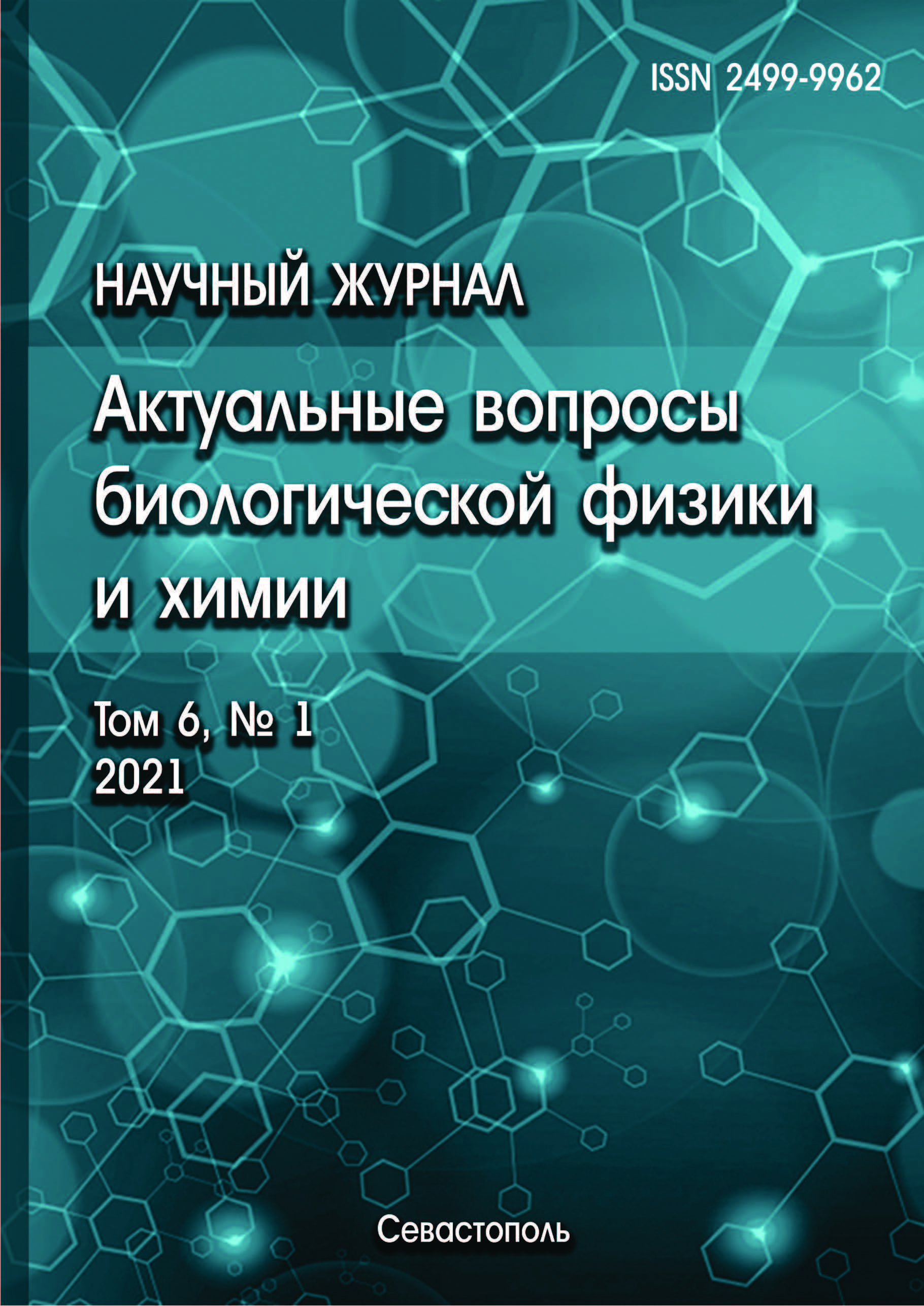Kotelnikov Institute of Radioengineering and Electronics of RAS (Fryazino branch)
Moscow, Moscow, Russian Federation
Pirogov Russian National Research Medical University
Kotelnikov Institute of Radioengineering and Electronics of RAS (Fryazino branch)
Moscow, Moscow, Russian Federation
Kotelnikov Institute of Radioengineering and Electronics of RAS (Fryazino branch)
Moscow, Moscow, Russian Federation
Free radical reactions play an important role in protecting the body from infections, in particular, in the response of cells of the immune system - neutrophils and macrophages to pathogens. The results of our studies showed that the response of neutrophils to various activators was enhanced as a result of exposure to microwave radiation. Irradiation changed the chemiluminescence (CL) kinetics of whole blood, to which activators were added, so that the CL of the irradiated blood samples was significantly higher. Comparison of the results of heating blood samples under the influence of microwave radiation and in a thermostat showed the same increase in the CL response of activated neutrophils. Measurement of CL of isolated neutrophils resuspended in plasma proved that the enhancement of neutrophil activation during irradiation is not mediated by other blood cells or platelets. Morphological analysis showed that microwave radiation activates neutrophils, i.e. increases the percentage of activated cells in suspension. It was also shown that radiation can weakly but reliably enhance the functional response of myeloperoxidase, an important neutrophil protein that is capable of producing reactive oxygen species (ROS). Thus, our studies have shown that microwave radiation enhances the response of neutrophils to the activation inducer in whole blood, increasing the production of ROS in the blood.
microwave radiation, human blood neutrophils, oxidative stress, chemiluminescence, reactive oxygen species, myeloperoxidase, EHF range
1. Agiwal M., Roy A., Saxena N. Next generation 5G wireless networks: a comprehensive survey. IEEE Commun Surveys Tuts, 2016, vol. 18, pp. 1617-1655. DOI: https://doi.org/10.1109/COMST.2016.2532458; EDN: https://elibrary.ru/XUPAQF
2. Ziskin M.C. Millimeter waves: Acoustic and electromagnetic. Bioelectromagnetics, 2013, vol. 34, rr. 3-14.
3. Szabo I., Kappelmayer J., Alekseev S.I., Ziskin M.C. Millimeter wave induced reversible externalization of phosphatidylserine molecules in cells exposed in vitro. Bioelectromagnetics, 2006, vol. 27, pp. 233-244. DOI: https://doi.org/10.1002/bem.20202; EDN: https://elibrary.ru/MFOXHD
4. Meena R., Kajal, K., Kumar, J., Rajamani P., Verma H. N., Kesari K.K. Therapeutic approaches of melatonin in microwave radiations induced oxidative stress mediated toxicity on male fertility pattern of Wistar rats. Electromagnetic Biology Medicine, 2014, vol. 33, pp. 81-91.
5. Yakymenko I., Tsybulin O., Sidorik E., Henshel D., Kyrylenko O., Kyrylenko S. Oxidative mechanisms of biological activity of low-intensity radiofrequency radiation. Electromagn Biol Med., 2016, vol. 35, pp. 186-202. DOI: https://doi.org/10.3109/15368378.2015.1043557; EDN: https://elibrary.ru/WOGYHV
6. Koyama S., Narita E., Suzuki Y., Taki M., Shinohara N., Miyakoshi J. Effect of a 2.45- GHz radiofrequency electromagnetic field on neutrophil chemotaxis and phagocytosis in differentiated human HL-60 cells. Journal of Radiation Research, 2015, vol. 56, pp. 30-36.
7. Kazarinov K.D., Borisenko G.G., Polnikov I.G. Vliyanie EMI nizkoy intensivnosti mikrovolnovogo diapazona na okislitel'nye processy v kletkah. Elektronnaya tehnika. Ser. 1. SVCh - tehnika, 2018, vyp. 1, № 536, c. 60-68. @@Kazarinov K.D., Borisenko G.G., Polnikov I.G. Influence of low-intensity EMR in the microwave range on oxidative processes in cells. Electronic equipment. Ser. 1. Microwave - technology, 2018, vol. 1, no. 536, pp. 60-68. (In Russ.)
8. Kazarinov K.D., Vlasova I.I., Mihal'chik E.V. Hemilyuminescentnye issledovaniya vliyaniya mikrovolnovogo izlucheniya na aktivaciyu neytrofilov. VI s'ezd biofizikov Rossii. Sbornik nauchnyh trudov, 2019, t. 2, c. 37. @@Kazarinov K.D., Vlasova I.I., Mikhalchik E.V. Chemiluminescent studies of the effect of microwave radiation on the activation of neutrophils. VI Congress of Biophysicists of Russia. Collection of scientific papers, 2019, vol. 2, p. 37. (In Russ.) EDN: https://elibrary.ru/DGHLAT
9. Poniedzialek B., Rzymski P., Nawrocka-Bogusz H., Jaroszyk F., Wiktorowicz K. The effect of electromagnetic field on reactive oxygen species production in human neutrophils in vitro. Electromagnetic Biology and Medicine, 2013, vol. 32, no, 3, pp. 333-341. DOI: https://doi.org/10.3109/15368378.2012.721845; EDN: https://elibrary.ru/RPLMIB
10. Safronova V.G., Gabdoulkhakova A.G., Santalov B.F. Immunomodulating action of low intensity millimeter waves on primed neutrophils. Bioelectromagnetics, 2002, vol. 23, no. 8, pp. 599-606. DOI: https://doi.org/10.1002/bem.10056; EDN: https://elibrary.ru/LHKBUP
11. Tuschl H., Novak W., Molla-Djafari H. In vitro effects of GSM modulated radiofrequency fields on human immune cells. Bioelectromagnetics, 2006, vol. 27, no. 3, pp. 188-196. DOI: https://doi.org/10.1002/bem.20191; EDN: https://elibrary.ru/MCSEAD
12. Lantow M., Lupke M., Frahm J., Mattsson M.O., Kuster N., Simko M. ROS release and Hsp70 expression after exposure to 1,800MHz radiofrequency electromagnetic fields in primary human monocytes and lymphocytes. Radiation Environmental Biophysics, 2006, vol. 45, no. 1, pp.55-62. DOI: https://doi.org/10.1007/s00411-006-0038-3; EDN: https://elibrary.ru/TQXRRT
13. Stankiewicz W., Dabrowski M.P., Kubacki R., Sobiczewska E., Szmigielski S. Immunotropic influence of 900MHz microwave GSM signal on human blood immune cells activated in vitro. Electromagnetic Biology and Medicine, 2006, vol. 25, no. 1, pp. 45-51. DOI: https://doi.org/10.1080/15368370600572961; EDN: https://elibrary.ru/MAHIPH
14. Sypniewska R.K., Millenbaugh N.J., Kiel J.L., Blystone R.V., Ringham H.N., Mason P.A., Witzmann F.A. Protein changes in macrophages induced by plasma from rats exposed to 35 GHz millimeter waves. Bioelectromagnetics, 2010, vol. 31, no. 8, pp. 656-663.
15. Barteri M., De Carolis R., Marinelli F., Tomassetti G., Montemiglio L.C. 2016. Effects of microwaves (900MHz) on peroxidase systems: A comparison between lactoperoxidase and horseradish peroxidase. Electromagn Biol Med., 2016, vol. 35, pp.126-133.










